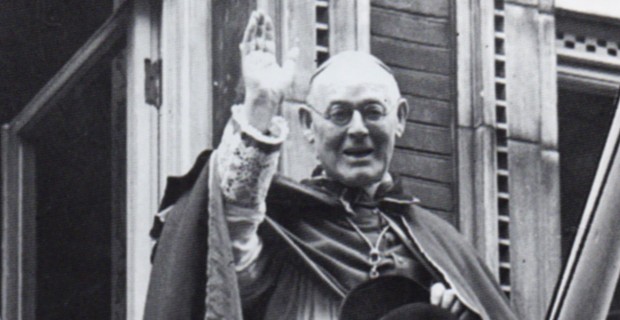Monday, August 19, 2013
Catholic Heroism and Villainy in Wartime
Arthur Cardinal Hinsley, Archbishop of Westminster, was such a strong voice against the Axis that when he died in 1943, King George VI expressed frustration that protocol prevented his attendance at the Requiem. When King George V and Queen Mary had attended the Requiem for the exiled Empress Eugenie at the Benedictine abbey in Farnborough in 1920, a stately remonstrance was sent from the Church of Scotland. On the other hand, royal protocols could loosen canonical strictures, and thus Catholic Eugenie was godmother at the Scottish Presbyterian baptism of Queen Victoria’s granddaughter and King Edward VII’s niece, Victoria Eugenie of Battenberg who in 1906 became a Catholic before marrying King Alfonso of Spain. Her logic was not complex: “If Uncle Eddie can be head of a Church, why can’t the Pope?” Queen Victoria, protectress of Anglicanism, had been godmother for the son of Napoleon III and Eugenie, her proxy at the baptism in Notre Dame cathedral being the Queen of Sweden, daughter of the adopted son of Napoleon I, Eugene de Beauharnais.
The Prince Imperial, Eugenie’s only child, died in South Africa in 1879 fighting under the British flag in the Battle of Ulundi, stabbed seventeen times by Zulu spears. He was wielding the sword Napoleon I carried at the Battle of Austerlitz. The Zulu Hlabanatunga disemboweled him to prevent his soul from seeking revenge. When the body of Prince Napoleon was brought back to England, Queen Victoria donated his tomb to the Catholic abbey. By an odd quirk, one of Cardinal Hinsley’s episcopal consecrators had been Merry del Val, son of the secretary of the Spanish legation in London and a close friend of the Empress Eugenie. Hinsley had also been Apostolic Visitor to British Africa, including Zululand. Churchill, innocent of ecclesiology, had so admired the cardinal that during World War II he wanted him be appointed Archbishop of Canterbury.
Over a couple of years I occasionally wrote for Crisis magazine about compelling people, particularly Catholic figures well known like Cardinal Hinsley, and others more obscure, who played their parts in World War II, from 1942 to 1943. Later I expanded this research and the result has just been published as a book called Principalities and Powers. My point all along was that the world’s most worldwide war, begun for mixed reasons and fought on many fronts, can only be understood in its essential dynamic as a spiritual combat between forces of great good and palpable evil. (more...)
Subscribe to:
Post Comments (Atom)

No comments:
Post a Comment